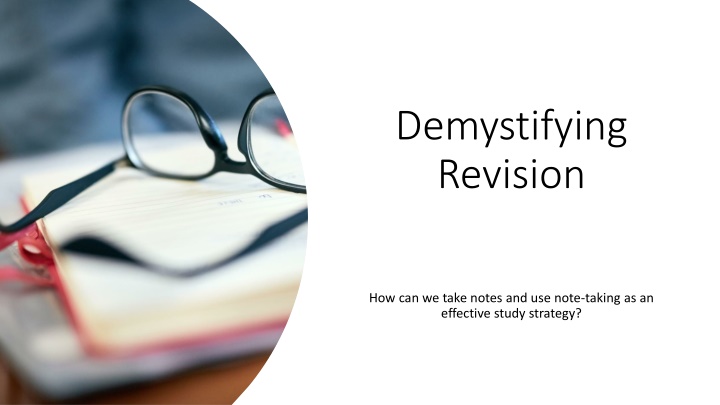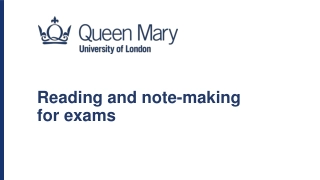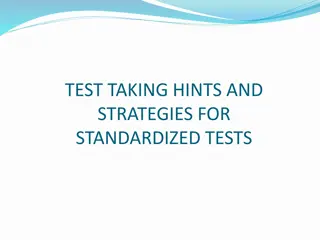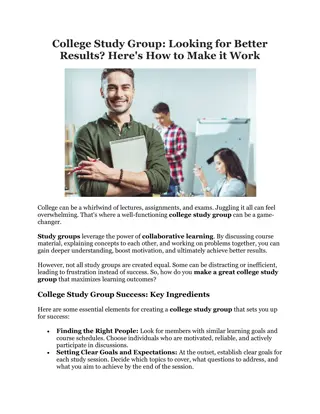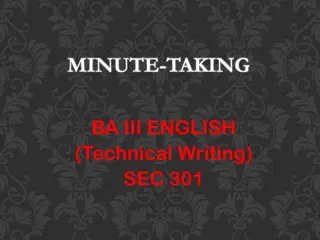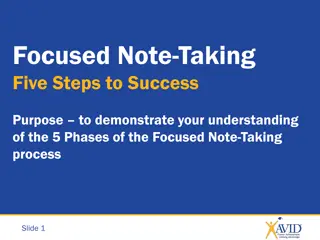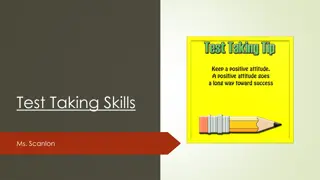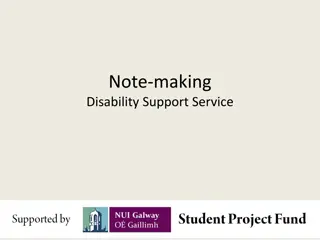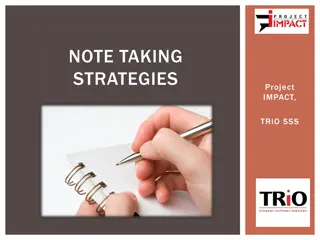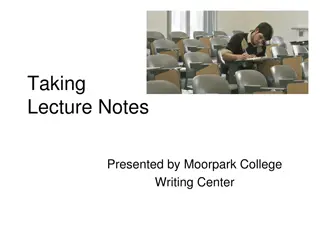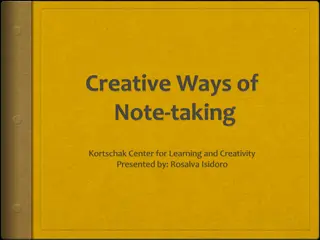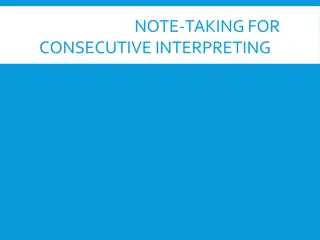Effective Note-Taking Strategies for Better Study Results
Discover effective study strategies for note-taking, memory platforms, and the Leitner method to enhance learning, retention, and revision. Avoid distractions, use Cornell Notes templates, and optimize flashcards for efficient studying. Learn the importance of automaticity in learning and benefit from key abbreviations and symbols for concise note-taking.
Download Presentation

Please find below an Image/Link to download the presentation.
The content on the website is provided AS IS for your information and personal use only. It may not be sold, licensed, or shared on other websites without obtaining consent from the author.If you encounter any issues during the download, it is possible that the publisher has removed the file from their server.
You are allowed to download the files provided on this website for personal or commercial use, subject to the condition that they are used lawfully. All files are the property of their respective owners.
The content on the website is provided AS IS for your information and personal use only. It may not be sold, licensed, or shared on other websites without obtaining consent from the author.
E N D
Presentation Transcript
Demystifying Revision How can we take notes and use note-taking as an effective study strategy?
Memory Platform Memory Platform What is it? How will it help me learn? How will it help me remember? How will it help me revise? Question 1 based on key knowledge from last lesson. Question 2 based on key knowledge from last lesson. Question 3 based on key knowledge from last lesson. Question 4 based on key knowledge from last term. Question 5 connect key knowledge from last lesson to knowledge from last term.
Memory Platform Memory Platform 1. List at least two distractions we need to avoid during an effective study session. 2. What should you do before a study session to ensure it is effective? 3. What should you do after a study session to ensure it is effective? 4. Why is automaticity important in learning? 5. How would automaticity in learning help us complete an effective study session?
Abbreviation/Symbol Meaning Abbreviation/ Symbol Meaning Note- Taking Symbols result of/consequence () Less important/extra information Therefore # Number @ At = equal to/the same as Money/financial : Causes increase/decrease Cont d Continued Dev p Develop/development Sim/diff Similar/different W Writer R Reader Bc Because e.g. For example Ch Chapter i.e. In other words Gov t Government Max/min Maximum/minimum P Page Re: Regarding Vs Versus w/ With * Important
Cornell Notes Template Title: Cues (questions) Notes Summary:
The Leitner Method A flashcard is a card containing a small amount of information used as an aid for learning. For revision, students can write questions on one side and answers on the other, testing themselves and re-ordering them according to which answers they were able to correctly recall. For flashcards to be effective, they should contain just a small amount of information (for example, a key word and definition or an image and a sentence related to that image in the target language for foreign language learning). Let s say it s Monday. Students take their flashcards and test themselves. If the information is recalled correctly, they place the card in Box Two. If they cannot remember the answer or answer incorrectly, it is placed in Box One: tested daily. On Tuesday, students test themselves on all the cards in Box One and Box Two. If a card from Box One is answered correctly, it moves to Box Two. If it is answered incorrectly, it stays in Box One. If a card from Box Two is answered correctly, it moves to Box Three (tested weekly). If it is answered incorrectly, it moves back to Box One. On Wednesday, students test on Box One cards, on Thursday Boxes One and Two and on Friday Boxes One and Three. If a card from Box Three is answered correctly, it stays there but if it is answered incorrectly, it moves back to Box One to be tested daily. This means students are getting the most practice on the flashcards they are weakest on. Basically, increasing the spacing slightly each time the information is correctly recalled is the most effective way to ensure the information enters long-term memory. Students are testing themselves on information just before they have forgotten it. The idea is that by making key knowledge so secure in students memories, they are better able to use this as a foundation on which to build excellent exam answers, add more knowledge, reducing cognitive load in their writing and enabling them to become experts . As explored in Step One, it s about building the factual recall to a point of automaticity so that students can easier access the higher-order thinking and ideas. It makes sense to start small so students might start by testing themselves on one part of one topic (e.g. key vocabulary about The Tudors) but the nearer they get to exams (from KS4 perhaps), they can interleave flashcards from different topics and even different subject areas.
The Leitner Method A flashcard is a card containing a small amount of information used as an aid for learning. For revision, students can write questions on one side and answers on the other, testing themselves and re-ordering them according to which answers they were able to correctly recall. For flashcards to be effective, they should contain just a small amount of information (for example, a key word and definition or an image and a sentence related to that image in the target language for foreign language learning). Let s say it s Monday. Students take their flashcards and test themselves. If the information is recalled correctly, they place the card in Box Two. If they cannot remember the answer or answer incorrectly, it is placed in Box One: tested daily. On Tuesday, students test themselves on all the cards in Box One and Box Two. If a card from Box One is answered correctly, it moves to Box Two. If it is answered incorrectly, it stays in Box One. If a card from Box Two is answered correctly, it moves to Box Three (tested weekly). If it is answered incorrectly, it moves back to Box One. On Wednesday, students test on Box One cards, on Thursday Boxes One and Two and on Friday Boxes One and Three. If a card from Box Three is answered correctly, it stays there but if it is answered incorrectly, it moves back to Box One to be tested daily. This means students are getting the most practice on the flashcards they are weakest on. Basically, increasing the spacing slightly each time the information is correctly recalled is the most effective way to ensure the information enters long-term memory. Students are testing themselves on information just before they have forgotten it. The idea is that by making key knowledge so secure in students memories, they are better able to use this as a foundation on which to build excellent exam answers, add more knowledge, reducing cognitive load in their writing and enabling them to become experts : it s about building the factual recall to a point of automaticity so that students can easier access the higher-order thinking and ideas. It makes sense to start small so students might start by testing themselves on one part of one topic (e.g. key vocabulary about The Tudors) but the nearer they get to exams (from KS4 perhaps), they can interleave flashcards from different topics and even different subject areas.
Cornell Notes Template Title: The Leitner Method Cues (questions) Notes Flashcard = card w/ small amount of info. Qus one side, answers other. Sts test themselves & reorder cards. spacing each time info = correct Builds factual recall automaticity sts can access higher-order thinking & ideas. Start small then interleave flashcards & make it more difficult over time. Summary:
Title: The Leitner Method Cues (questions) Notes What is a flashcard and how should we use them? How does The Leitner Method use spacing? Why are flashcards effective? Flashcard = card w/ small amount of info. Qus one side, answers other. Sts test themselves & reorder cards. Cornell Notes Template spacing each time info = correct Builds factual recall automaticity sts can access higher-order thinking & ideas. Start small then interleave flashcards & make it more difficult over time. How should we start using flashcards and how should we increase challenge? Summary: The Leitner Method uses flashcards as a learning aid, helping knowledge enter long- term memory through repetition and spacing.
Turning Notes into Full Sentences Title: The Leitner Method Cues (questions) Notes What is a flashcard and how should we use them? How does The Leitner Method use spacing? Why are flashcards effective? Flashcard = card w/ small amount of info. Qus one side, answers other. Sts test themselves & reorder cards. spacing each time info = correct Flashcard = card w/ small amount of info. Qus one side, answers other. Sts test themselves & reorder cards. Builds factual recall automaticity sts can access higher-order thinking & ideas. Start small then interleave flashcards & make it more difficult over time. How should we start using flashcards and how should we increase challenge? Becomes A flashcard, a card containing a small amount of information, has questions or cues on one side and an answer on the other. Students use flashcards to test themselves, reordering the cards and retesting. Summary: The Leitner Method uses flashcards as a learning aid, helping knowledge enter long- term memory through repetition and spacing.
Title: The Leitner Method Now quiz each other using the cues and concealing your notes! Cues (questions) Notes What is a flashcard and how should we use them? How does The Leitner Method use spacing? Why are flashcards effective? Flashcard = card w/ small amount of info. Qus one side, answers other. Sts test themselves & reorder cards. spacing each time info = correct Builds factual recall automaticity sts can access higher-order thinking & ideas. Start small then interleave flashcards & make it more difficult over time. How should we start using flashcards and how should we increase challenge? Summary: The Leitner Method uses flashcards as a learning aid, helping knowledge enter long- term memory through repetition and spacing.
Learning Reflection Reflect on your Cornell-notes quizzing: What could you remember easily? What was more difficult to remember? Which questions did you struggle with? Why do you think that was? Do you think you could remember this information as well in a week, month or year? The limits of our working memory mean we need to space and repeat our quizzing!
